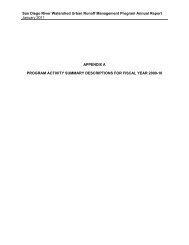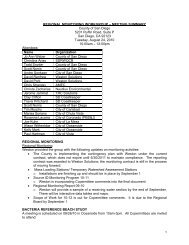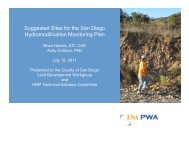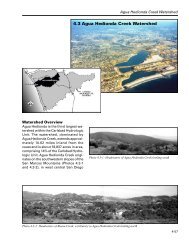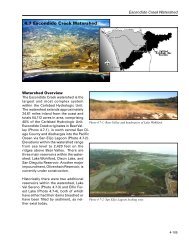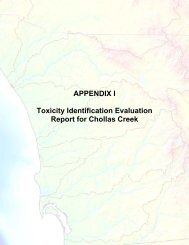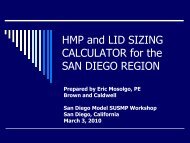APPENDIX I Toxicity Identification Evaluation Reports for Chollas ...
APPENDIX I Toxicity Identification Evaluation Reports for Chollas ...
APPENDIX I Toxicity Identification Evaluation Reports for Chollas ...
Create successful ePaper yourself
Turn your PDF publications into a flip-book with our unique Google optimized e-Paper software.
<strong>Toxicity</strong> <strong>Identification</strong> <strong>Evaluation</strong> of <strong>Chollas</strong> Creek<br />
Stormwater using Hyalella azteca<br />
Materials and Methods<br />
August 2006<br />
3. MATERIALS AND METHODS<br />
3.1 TEST PROCEDURES<br />
Bioassay methods <strong>for</strong> the species H. azteca test are from the USEPA guidance manual,<br />
“Methods <strong>for</strong> Measuring the <strong>Toxicity</strong> and Bioaccumulation of Sediment-associated<br />
Contaminants with Freshwater Invertebrates” (USEPA, 2000).<br />
3.1.1 <strong>Toxicity</strong> Test Using Hyalella azteca<br />
Stormwater tests <strong>for</strong> acute toxicity using the freshwater amphipod H. azteca were per<strong>for</strong>med<br />
according to a modified version of the USEPA protocol <strong>for</strong> testing sediment-associated<br />
contaminants with freshwater invertebrates (EPA/600/R-99/064). This protocol provides test<br />
methods <strong>for</strong> measuring acute and chronic toxicity in Hyalella exposed to freshwater sediments,<br />
as well as a test method <strong>for</strong> conducting a water-only acute reference toxicant test. The<br />
reference toxicant test protocol was modified to conduct the toxicity testing on samples collected<br />
from the mass loading stations. The test solution was prepared and 250-mL aliquots were<br />
placed into four replicate test chambers. Clean sand was placed as a thin “monolayer” in the<br />
bottom of the test chamber. Temperature, pH, dissolved oxygen, and salinity were measured at<br />
test initiation prior to adding organisms. Ten organisms per replicate were added. Tests were<br />
run at 23 ± 1°C under a 16 hour light: 8 hour dark photoperiod. Water quality was per<strong>for</strong>med<br />
daily on a surrogate chamber. The animals were exposed <strong>for</strong> four days, and fed on day 0 and<br />
2. At the end of the test, the survivors were removed from the sand and counted. Prior to<br />
analysis of the data, test acceptability was determined by evaluating the response of the control<br />
organisms. The test was considered invalid if survival of control animals was less than 90%. A<br />
reference toxicant test was conducted using copper sulfate with concentrations of 62.5, 125,<br />
250, 500, and 1000 µg Cu 2+ /L to establish the sensitivity of test organisms used in the<br />
evaluation of the <strong>Chollas</strong> Creek stormwater.<br />
3.2 TEST SOLUTION PREPARATION<br />
Control and dilution water <strong>for</strong> the H. azteca tests was Evian mineral water that was diluted<br />
with deionized water to achieve a moderate hardness (80-100 mg/L as CaCO 3 ). This water<br />
source has been used successfully on numerous similar bioassay testing programs conducted<br />
by Weston and others. Extensive testing with a variety of species and biannual chemical<br />
analysis of this water type has shown that this water source provides <strong>for</strong> good survival in<br />
laboratory controls with little to no measurable levels of contaminants.<br />
3.3 WATER QUALITY<br />
Water quality was monitored daily as appropriate <strong>for</strong> each test, and data were recorded on data<br />
sheets. Dissolved oxygen and temperature was measured using Orion Model 840 oxygen<br />
meters and probes; pH was measured using Orion Model 230A pH meters and probes.<br />
Conductivity was measured with Orion Models 142 conductivity/salinity meters. Ammonia<br />
was analyzed using an Orion 720 digital ion analyzer with a three-point calibration curve (1,<br />
10, and 100 mg/L). Hardness and alkalinity were measured utilizing LaMotte titration kits.<br />
3.4 SAMPLE RECEIPT<br />
The stormwater samples were composited at the laboratory and stored at 4°C. A chain-ofcustody<br />
was completed <strong>for</strong> all samples received. Be<strong>for</strong>e samples were used in the tests, initial<br />
Weston Solutions, Inc. 8







